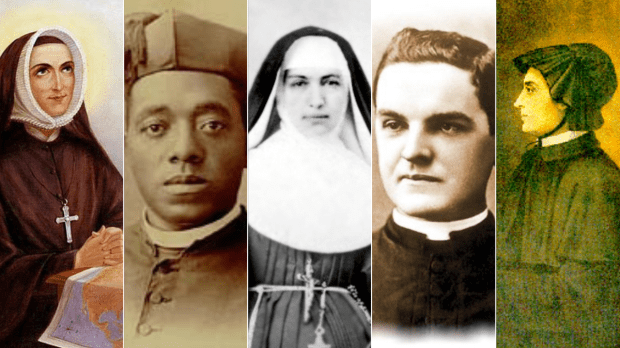Monday 31 October 2022
~
1. The United States’ lack of saints
2. Seminaries in Italy, a model in ruins
3. Cardinal Zuppi celebrates the vespers of the “Summorum Pontificum” pilgrimage
4. Cardinal Kambanda speaks about his vocation
5. Archbishop of Algiers welcomes Gallagher’s visit
~
1The United States’ lack of saints
As the Church approaches All Saints Day, managing editor of American media outlet Crux, Charles Collins, wonders, “Where are the American saints?” Only around a dozen people who lived or were from the US have been canonized and around the same number beatified, Collins writes. However, there are hundreds of Americans somewhere in the process of sainthood; thus a lack of saints does not mean a “lack of people in the history of the American Church who could be raised to the altars.” Collins explains that one of the reasons for this small number is because the US is a “young” Catholic country, like Brazil or the Philippines, and thus has less experience “negotiating the labyrinth” that is the “complex and bureaucratic” process for canonizing saints. Additionally, Collins recognizes that the attitude of the local population also influences the canonization process of an individual. “U.S. Catholics are just less likely to bang down the bishop’s door to demand someone be made a saint,” unlike Italians or the French, the American journalist explains. He attributes this attitude to “the influence of our largely Protestant society.” “To some degree, the “Weird Catholic” world of stigmatists, miracles, and relics which permeates the faith in Southern Europe is a cause of embarrassment for Catholics that spent much of the 20th century trying to convince Episcopalians and Methodists that the Catholic Church is intellectual and modern,” Collins explains, saying it is a shame since a country’s saints should be a “point of pride to its people.”
Crux, English
2Seminaries in Italy, a model in ruins
The right-wing Italian daily Il Foglio paints a disturbing picture of the decline in priestly vocations in Italy, noting that entries into seminaries are following, with a few years’ delay, the same declining curve as in other European countries such as France. In the last 50 years, vocations have dropped by more than 60%, from 6,337 seminarians in 1970 to 2,103 in 2019, notes journalist Matteo Matzuzzi. “Today, there are more or less 1,800 aspiring priests in Italy, and if the average age of the clergy is taken into account, it is easy to see that there will soon be a problem of parish coverage, with priests being called to work overtime and to be more and more functionaries than fathers. The breach has been open for some time and the issue goes far beyond figures and statistics,” the newspaper warns, pointing out that a threshold of 300 ordinations per year would be needed to sustain the current parish system. Statistics for 2018 showed that 248 priests had been ordained in Italy, compared to 114 in France. This seemingly comfortable figure hides a lasting and deep decline, along with a malaise that Pope Francis made palpable through his words on October 24, as he warned seminarians against addiction to pornography. Psychological support for seminarians will be one of the topics discussed in the next assembly of Italian bishops. However, the very model of the seminary is at stake in certain mindsets, “mostly on the side of liberal Catholicism,” which put “on the table all the clues that would lead to the seminary’s condemnation: young men who as soon as they enter begin studying Italian, dreaming of a Roman career, putting on cassocks and even cufflinks.” This vision of the priesthood shows “a whiff of clericalism and traditionalism” and brings “indications that something is wrong,” while the current pontificate should motivate aspiring priests to turn to “the poor, the peripheries and the ecclesiology of Vatican II.” However, this idea is simplistic. “Seminaries may have to be rethought, but the beliefs of those who think that seminaries and formation centers are just Noah’s arks where kids with mental problems or who feel lonely go to hole up trying to escape from the toils of the world will also have to be updated,” Matzuzzi writes.
Il Foglio, Italian
3. Cardinal Zuppi celebrates the vespers of the “Summorum Pontificum” pilgrimage
Although known for being part of the “progressive” wing of the Church, Cardinal Matteo Zuppi agreed to preside, on October 28 at the Pantheon – or Basilica of St. Mary and the Martyrs – at the Vespers of the pilgrimage “Summorum Pontificum,” organized by the Institute of the Good Shepherd. Despite the restrictions required by Pope Francis on celebrations according to the ancient rite, Cardinal Zuppi is known for his benevolence toward the faithful of the ancient liturgy.
National Catholic Register, English
4. Cardinal Kambanda speaks about his vocation
Cardinal Antoine Kambanda, Archbishop of Kigali and the first to represent Rwanda in the College of Cardinals, reflects on his personal journey, marked by the trauma of the 1994 genocide but also by a deep hope in the healing brought by the Christian faith.
Alfa Y Omega, Spanish
5. Archbishop of Algiers welcomes Gallagher’s visit
In a difficult context for the small Church in Algeria, which has had to close its Caritas branches for administrative reasons, the visit of the Vatican’s “Minister of Foreign Affairs,” Archbishop Paul Richard Gallagher, has brought “lights of hope,” says the Archbishop of Algiers, Jean-Paul Vesco.
Zenit, French

